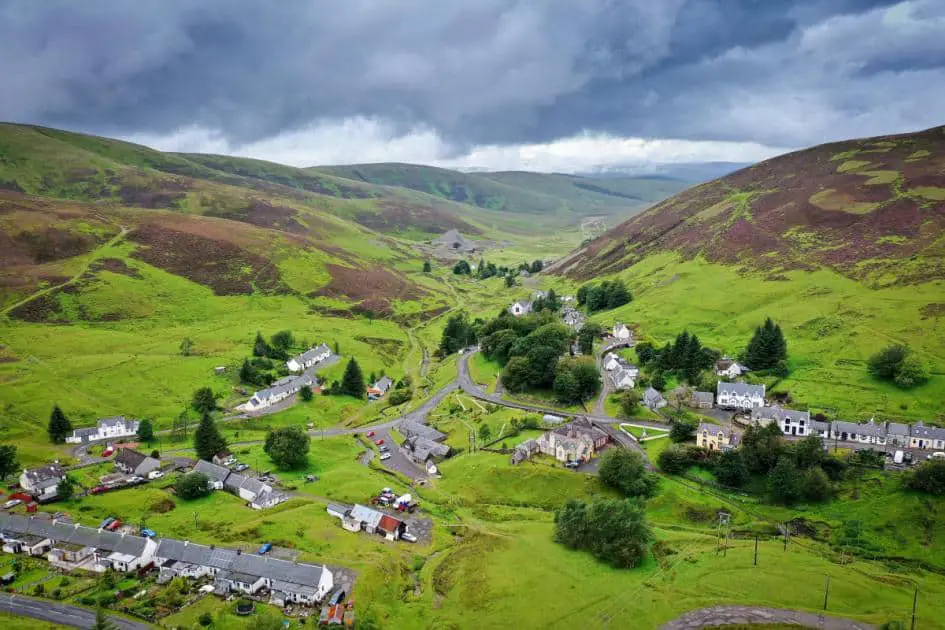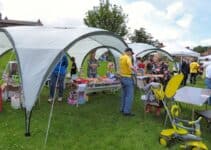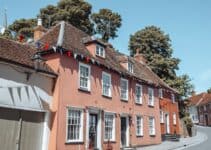Scotland is known for being a pretty hilly country. There are plenty of reasons to explore its amazing countryside, one of which is looking for the highest village.
Searching for it can take you to some interesting places, and you’ll easily find plenty to do in the surrounding area.
So, in this article, we’ll look at what is the highest village in Scotland and discuss some of the many reasons to visit.
What is The Highest Village in Scotland?
The highest village in Scotland is Wanlockhead. Surprisingly, it’s not actually in the Highlands, but is instead located in the Southern Uplands. Located in Dumfries and Galloway, it’s right next to the English border.
Wanlockhead is located 405m above sea level, but its highest house is somewhere around 444m. This makes it far higher than the highest village in the Highlands, which we’ll discuss later.
Wanlockhead
Although the village of Wanlockhead wasn’t founded until 1680, the area was in use from the Roman occupation. Romans mined lead and other deposits in the surrounding hills, which were then left until the 13th century.
By that time, Scottish miners began exploiting deposits, and the village was founded in the 17th century to establish a permanent mine.
Lead was its biggest resource, but the area was also known for copper, zinc, silver and gold. In fact, its gold deposits were some of the purest in the world (22.8 carats) and were used to make the Scottish crown.
Lead mining continued in the area until the 1950s, when mines were shut down due to them not being cost-effective. Nowadays, Wanlockhead is mostly a sleepy Scottish village that attracts a small collection of tourists in the summer, along with plenty of hikers.

What to Do in Wanlockhead
Other than walking around admiring its beauty, there are a few things worth doing in Wanlockhead. There’s the Museum of Lead Mining, which, unsurprisingly, explains the area’s history and the importance of its mines.
Related to this is the Leadhills and Wanlockhead Light Railway. It’s Britain’s highest adhesion railway (wheels running on a rail). The railway originally ran more than 456 metres above sea level. Although it was closed in 1938, a section was reopened and you can take trips on it in the summer.
While in Wanlockhead, make sure you check out Straitsteps Cottages, a terrace row that’s been restored to show what it was like living there in the 18th and 19th centuries.
They’re miners’ houses to show what residents of Wanlockhead would’ve lived like while working the lead mines.
Finally, there’s the Wanlockhead beam engine. It’s a water-powered engine that was used to drain water from the mines.
Although it might not sound like the most interesting thing to see, it’s the last remaining water-powered beam engine in the UK and still stands in its original location, where it’s been for nearly 200 years.
The beam engine is a Scheduled Historic Monument that’s owned and maintained by Historic Scotland. Due to its important role in improving mining, it’s an important piece of historic machinery that’s definitely worth checking out if you’re into this sort of thing.
You’ll also find all the usual things you’d expect in a quaint countryside village: a pub, a tearoom, and a library. Wanlockhead is also part of the Southern Upland Way, a 214-mile walking trail that cuts through some of the nicest parts of Southern Scotland.
What is the Second Highest Village in Scotland?
Luckily, if you’re into high-up villages and want to visit the second-highest one in Scotland, you won’t have to travel far. So, where is the second-highest village in Scotland?
The second highest village in Scotland is Leadhills, located 445m above sea level. It’s only 3km away from Wanlockhead, and both villages were founded to house miners working in the local hills. As the name might suggest, Leadhills was founded to exploit lead deposits in the area.
Leadhills was officially founded around the same time as Wanlockhead and is known for many of the same things. Aside from its mining-related history, Leadhills is home to grouse moors, which are used as a hunting area.
Another important landmark is Leadhills Golf Course, the highest in Scotland. Originally opened in 1891, it’s a 9-hole course that’s known for being quite challenging.
The high winds associated with the elevation can make play very difficult and unpredictable.
Finally, there’s the area’s association with winter sports. Lowther Hills (the area covering Leadhills and Wanlockhead) is believed to have historic links to Scottish winter sports. One of the country’s first curling societies was established in Leadhills in 1784 and was a popular pastime for miners.
Leadhills also houses Scotland’s only community-owned ski centre, which is the only ski area in south Scotland. Although it doesn’t host skiing events every year (as it depends on the weather), skiing is popular in the area when it can happen.
What is the Highest Village in the Scottish Highlands?
Considering the area is called the Highlands, it’s probably surprising that it isn’t home to the highest village in Scotland. If nothing else, it just goes to show how hilly and elevated Scotland really is! So, what is the highest village in the Scottish Highlands?
The highest village in the Scottish Highlands is Tomintoul. At an elevation of 345m above sea level, it’s quite far behind Wanlockhead and Leadhills. Of course, it’s still pretty far above sea level.
One reason why it’s so much lower is partly because of the way Scotland is populated. The Highlands are far less densely populated than south Scotland, which is closer to the English border and therefore had more economic prospects in the form of trade.
But another reason is just sheer convenience. Back when these villages were founded (the 17th and 18th centuries), building at such high elevations was inconvenient at best.
All the building materials would have to be taken to the area by hand (or horse) or quarried in the immediate area. Regardless of which option you used, it took a lot longer to get the materials up a hill.
Wanlockhead and Leadhills were therefore founded out of necessity more than anything else. The payoff of mining all the lead and other resources outweighed the difficulty of establishing a village that high up.
Tomintoul, on the other hand, was founded to reduce crime rates in the area. Because of its remoteness, farmers were illegally distilling spirits, which they then smuggled to neighbouring areas.
Alexander Gordon, the village’s founder, set it up to cut down on these illicit distilling activities, and cattle theft.
The village was established in 1775 and, in 1820, more than 14,000 illegal stills were confiscated in the area, showing Gordon’s plans didn’t work! However, the Excise Act of 1823 allowed some farmers to start distilling spirits legally. This led to the creation of a fairly well-known whisky brand: Glenlivet.
The Glenlivet Distillery
Tomintoul is situated in an area called the Livet glen. After the Excise Act was set up, some farmers decided to legally start distilling spirits, as they already had the equipment and could make far more money than if they farmed cattle.
One such farmer was George Smith, who was the first person in Scotland to apply for a license to distil spirits. He founded the original Glenlivet distillery in Minmore in 1824.
Near the end of the 19th century, other distillers had set up in the area and began using the same name. Glenlivet distillery sued them and won the right to use the official Glenlivet name.
Over time, and due to various economic reasons, Glenlivet whisky went on to become the second-best selling single malt whisky in the world. It’s the best-selling malt whisky in the US and has global sales of more than 6 million bottles a year.
What to Do in Tomintoul
Tomintoul itself doesn’t have loads of tourist-related activities, although it offers loads of accommodation. This is partly because it forms part of the Whisky Trail, which is one of the area’s biggest attractions.
Unsurprisingly, the Whisky Trail involves travelling around 8 distilleries in the area, which include both Glenfiddich and Glenlivet.
The whole trail can be done in a day because the distilleries are fairly close together. However, for obvious reasons, you might want to spend a couple of days doing it instead to make the hangovers easier!
Other than the trail, there’s a museum that focuses on life in the Highlands. The Glenlivet Estate is also a major draw for tourists. It hosts walking and riding trails and fishing lakes.
The estate is home to the Glenlivet distillery mentioned above and is a great example of some of the amazing scenery that characterises the Scottish Highlands.
Final Thoughts
So there you have it, everything you could need to know about the highest villages in Scotland. Luckily, there’s plenty to do in each of the villages if you’re interested in local history (and/or drinking whisky).
Visiting these villages is definitely a great way to experience Scotland, although the country hardly needs themed visits to make it enjoyable.


